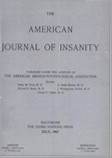HEREDITARY FORM OF PRIMARY PARENCHYMATOUS ATROPHY OF THE CEREBELLAR CORTEX ASSOCIATED WITH MENTAL DETERIORATION
Abstract
In a family traced through three successive generations five members were afflicted with symptoms of ataxia and mental deterioration of varying degree. The children of three of the sibs of the third generation are in good health. The age of onset was between 40 and 50 years. The course of the disease was rapidly progressive and death occurred within two years of onset.
Case 1.—Gradual onset of a slight difficulty in speaking and swallowing appeared at the age of 40, two years before death. One year later developed diplopia and blurring of vision which subsequently disappeared. Six months before death, onset of difficulty of gait which steadily increased so that three months before death he was unable to walk without assistance. Two months before death incoordination of right arm was noticed. At this time he became somewhat untidy in his personal habits and was subject to occasional periods of confusion. On admission to the Strong Memorial Hospital he presented evidence of marked cerebellar disturbance. Four days after an exploratory craniotomy the patient died.
Pathological examination revealed no gross atrophy of the cerebral cortex but microscopic study showed a diffuse involvement of the nerve cells in third and fifth layers of the frontal cortex and to a less degree of the parietal cortex. In the cerebellum, no gross atrophy was found. Microscopically, an elective destruction of Purkinje cells with preservation of the basket fibers was found. These changes were most marked in the superior vermis and to a less extent in the corresponding portions of the hemispheres, namely, the vinculum lingulæ, ala lobule centralis and the lobulus quadrangularis. The spinal cord was normal.
Case 2.—Onset of an agitated depression and awkwardness of movements at the age of 50, one year before death. Six months later developed weakness, a difficulty in speech, and some dysphagia. Four months before death onset of mental symptoms, suggestive of organic brain disease, and an ataxic gait. Rapid progression of symptoms during the last two months of life. Following admission to the Rochester State Hospital temporary improvement occurred but patient died of pneumonia.
Pathological examination revealed a gross atrophy of the frontal and parietal lobes. Microscopic study of the cerebral cortex showed similar changes as in Case I, except that they were more marked. The cerebellum showed no atrophy grossly. Microscopically, the changes were similar to that found in Case I, except that the process was more acute.
Access content
To read the fulltext, please use one of the options below to sign in or purchase access.- Personal login
- Institutional Login
- Sign in via OpenAthens
- Register for access
-
Please login/register if you wish to pair your device and check access availability.
Not a subscriber?
PsychiatryOnline subscription options offer access to the DSM-5 library, books, journals, CME, and patient resources. This all-in-one virtual library provides psychiatrists and mental health professionals with key resources for diagnosis, treatment, research, and professional development.
Need more help? PsychiatryOnline Customer Service may be reached by emailing [email protected] or by calling 800-368-5777 (in the U.S.) or 703-907-7322 (outside the U.S.).



